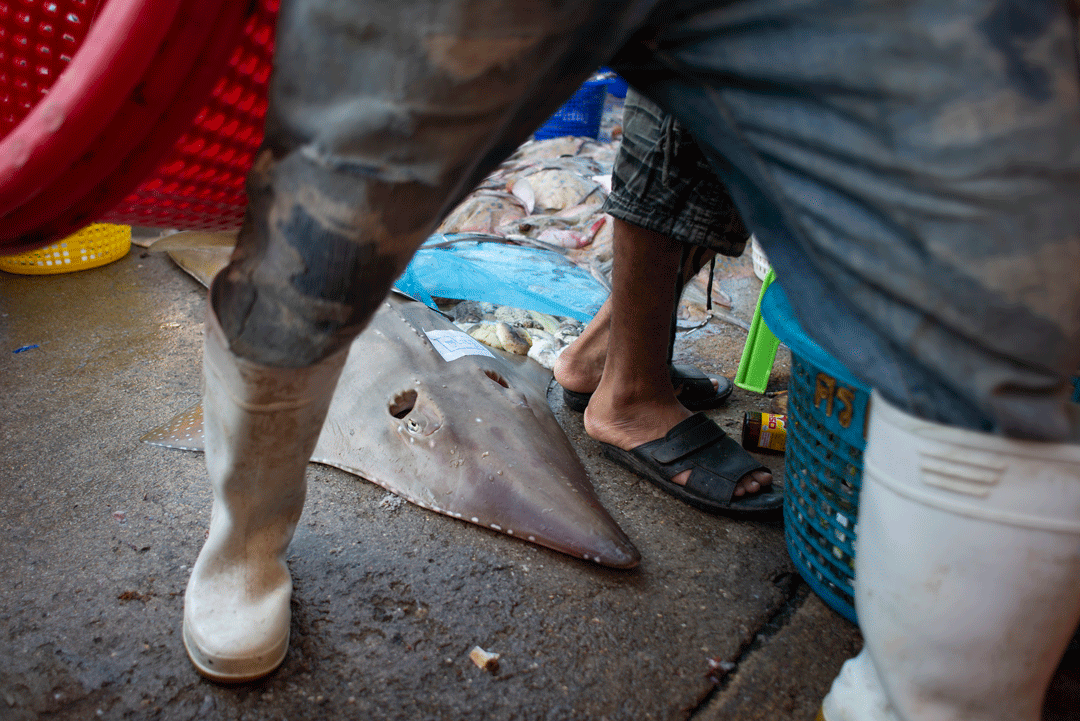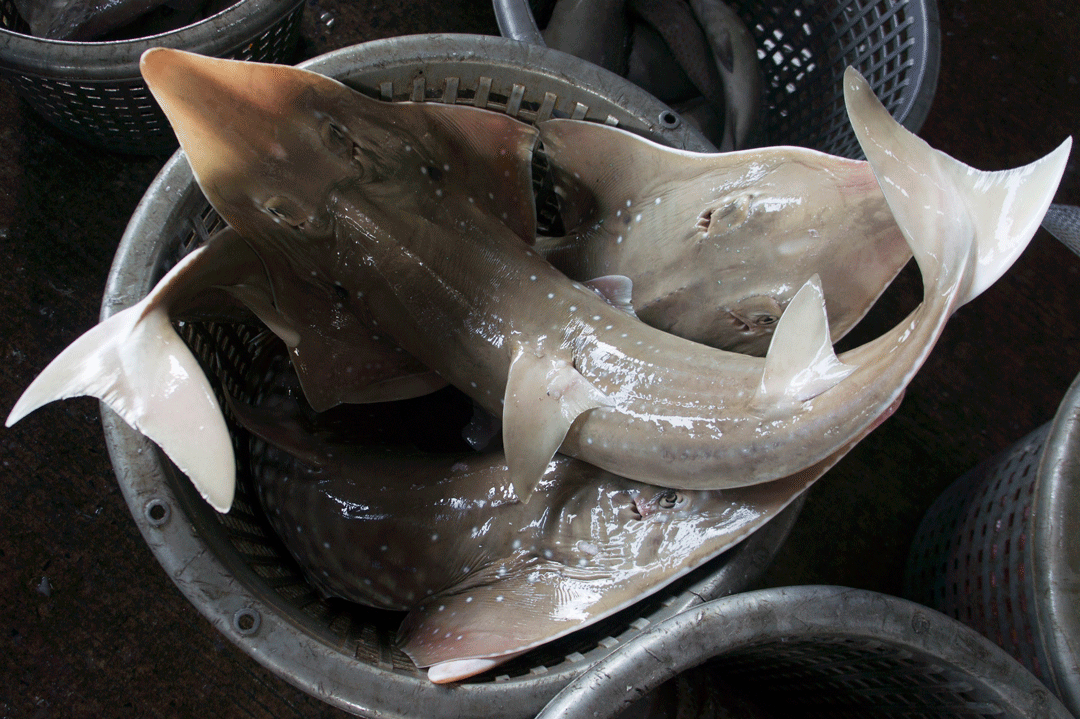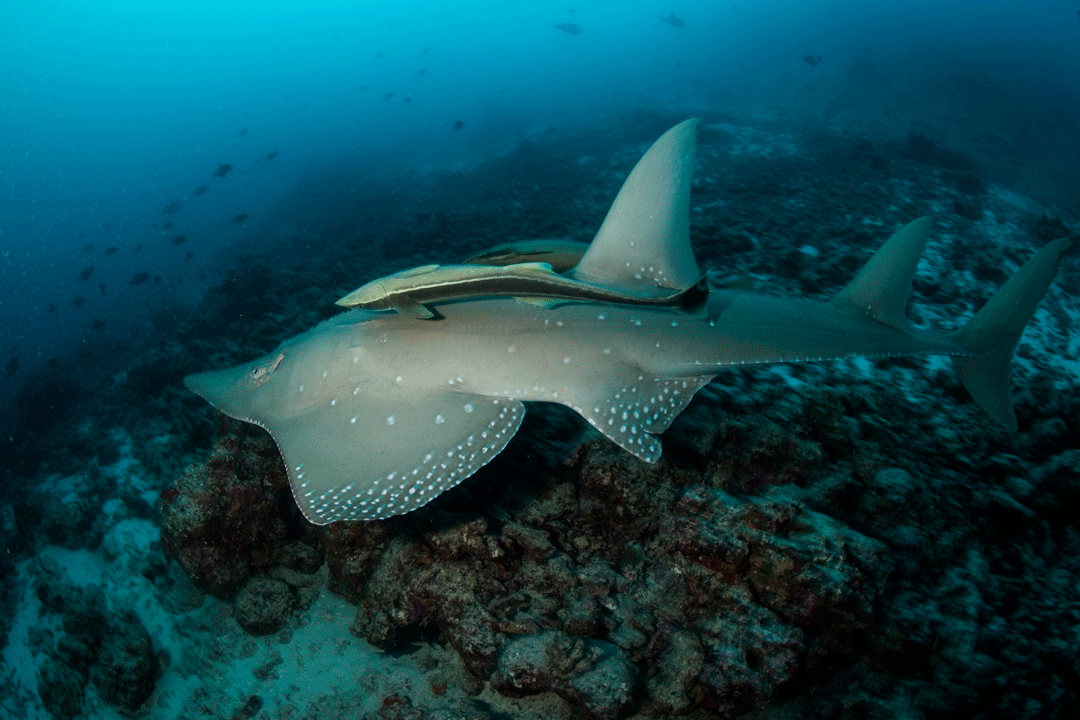Why the fuss about wedgefishes and giant guitarfishes this week?
In July this year, an update to the International Union for Conservation of Nature’s (IUCN) Red List of Threatened Species saw 9 out of the 10 recognised species of wedgefish classified as Critically Endangered. All six species of giant guitarfish were classified the same. This category, the highest threat ranking by the IUCN on their barometer of vulnerability, indicates that their populations face an imminent, high risk of extinction in the wild. It was an announcement that stunned the conservation world – or at least, those among the community who’d never heard about these secretive shark-like rays that cruise the ocean floor. For scientists tasked with assessing these populations, the outcome was perhaps less surprising. Nations are now focused on a proposal to list all 16 species of wedgefishes and giant guitarfishes on CITES Appendix II. If adopted, the listing will require member nations (183 governments are a party to the Convention) to demonstrate that any trade in these species is legal and sustainable. But there is more to the story of these shark-like rays, and how they’ve found the spotlight this week. Understanding how it is that we now know they are amongst the most threatened fishes in the sea means delving into the scientific steps that come before a “Critically Endangered” label.

Wedgefish are a common sight in the by-catch of demersal fisheries, which use gear such as gill-nets, long-lines, trawls, trammel nets and tangle nets. This juvenile bottlenose wedgefish, displayed for auction at a fish landing site in Ranong Province, Thailand, would not yet be mature. Photo © Sirachai "Shin" Arunrugstichai
How did these species end up on the CITES agenda?
Proposing species for consideration of a CITES listing requires evidence. For wedgefishes and giant guitarfishes, that means meeting a set of pre-determined CITES biological and trade criteria. This usually means that a population is in serious decline, is limited in its range, or has diminishing quality habitat. For Appendix II, experts should also show that regulating trade is necessary to prevent that species from extinction in the wild, as opposed to some other form of conservation intervention. Some of that evidence comes from population assessments, and the latest of these comes in the form of the IUCN’s Red List. This list was informed by a group of scientists tasked with updating what we know about the state of the shark-like rays in wild ocean waters around the world.
Dr Peter Kyne is the IUCN Red List Authority Coordinator for the IUCN Shark Specialist Group (SSG), and lead author of the publication “The thin edge of the wedge: extremely high extinction risk in wedgefishes and giant guitarfishes”, a study that raised the flag ahead of the updated IUCN announcements released last month. His ten co-authors include the Global Shark Trends Project Principal Investigator and Shark Specialist Group chair Dr Nick Dulvy and senior Red List officer Cassandra Rigby.
“The Global Shark Trends Project, funded by the Shark Conservation Fund, is committed to reassessing the status of chondrichthyans over a period of 3 years. The IUCN Red List assessments have a maximum lifespan of 10 years, so we have to update the information for species periodically. And this was the first full reassessment that is part of a larger project reviewing 1250 species”. Peter explains that these are held over a period of regional workshops, where experts from around the world review different themes. The shark-like rays, which also include guitarfishes, sawfishes and banjo rays, were considered a conservation priority:
“It was very evident that there were issues with this group in particular, and that we needed to assess them to categorise them on the Red List. The result of that was that all but one species of the wedgefishes and giant guitarfishes met the criteria for Critically Endangered status,” he concludes.
For a group of rays that have long skirted the edges of general conservation consciousness, any inkling of their plight might have been the preserve of those whose research careers and interests were attentive to them. “We knew,” explains Peter, “from the information we had, that these species would be somewhere on this spectrum of concern. A previous regional assessment from the Arabian Sea, by Rima Jabado, showed that the species in that region (spanning the ocean from Somalia to Sri Lanka) were highly threatened. So with the information that we now had to conduct the latest assessment – well, it wasn’t too surprising to see the results”.

Wedgefish are a highly prized species whose fins are the most sought after on the international shark-fin trade. Mature wedgefishes, at about three metres (10 feet) long, have very large fins that can fetch more than US$700 per dry kily in the South-East Asian fin market trade. Photo © Sirachai "Shin" Arunrugstichai
So what happened over the course of 10 years to put these shark-like rays at the forefront of our concern?
It’s tricky to unpack why this IUCN listing is perhaps not so surprising to scientists who have worked on these species for years. To answer this question, Peter clarifies the complexity of the assessment process: “The move (from Vulnerable, where most wedgefishes and giant guitarfishes were already classified, to Critically Endangered) itself we call a non-genuine change. That is, it’s not to say the species’ population has necessarily deteriorated rapidly in the last 10 years. Rather, it’s that the information we now have to assess their populations is of better quality. We now have data from catch landings at locations such as Pakistan, and Indonesia, and we could use that higher resolution and quantity of data to inform this latest assessment. If we had the same quality information 10 years ago, we may have arrived at the same conclusion”.
The continuous practice of collecting new, and better, information is part of why these assessments are updated over the years. It’s a process that Peter and his colleagues know well: “Red List categories have five levels of data quality, where the highest level requires that you have data for every individual in a species. Of course, that doesn’t work for a wedgefish. It works, perhaps, for a tree species where you can go count every remaining individual and monitor changes over time. We’re often, in the marine sector, at the lower end of the five data quality categories, and operate in inference and anecdotal information”.
Of the 16 species of wedgefish and giant guitarfish, 13 are found in the Indo-West Pacific region, their centre of abundance. Three others are found in the eastern Atlantic. On the subject of how it is that scientists laboriously work with the best available information to try to update and understand population trends, Peter gives a nod to necessary caution: “In the eastern Atlantic, we had to use more generalized data and inference. This might be in the form of surveys at fish markets and landing sites, and trawling through the literature to note which species were recorded decades ago, and where they are no longer reported. However, we had good coverage of data for the Indo-West Pacific, the area from the Arabian Sea and Pakistan to Indonesia and Australia”.
For those in the technical-know, the information from this ocean area came in the form of data from fish landing sites, aggregated into the groups ‘wedgefishes’ and ‘giant guitarfishes’. Peter continues: “In all the areas we were looking at, fishing effort has continued to increase. In this case, we could look at the landings and assess ‘They’ve decreased by X%’, and then look at the fishing effort, and note, for example, that ‘Region X has doubled its effort in 10 years’. If we know that fishing effort (a measure of the amount of fishing, either by hours or days spent fishing, or the number of hooks or nets used) is going up, but the landings (the quantity of fish being brought back to harbour) are going down, we can infer population declines”.

A neonate bottlenose wedgefish, its unhealed umbilical scar still visible, is handled by a fisherman in a holding pond after being caught in a crab net in Chonburi Province, Thailand. Photo © Sirachai "Shin" Arunrugstichai
So what’s do to about wedgefishes?
For anyone who’s been paying attention to conservation news since the announcement of the updated IUCN listings last month, and who is keeping tabs on proceedings at CITES this weekend, the situation certainly seems dire. But Peter steers gently away from an altogether bleak outlook, noting: “If we want to find a positive in all this, it’s that we’ve identified that the situation for these species in Australia is a lot better off than the rest of their range. That’s true for four of the species found in northern Australia, where human populations are small and the region is more remote, so the overall fishing pressure is lower. Here, at least, there is a ‘lifeboat’ for four species.”
And if the long road to potential trade regulations has landed the fate of these flattened fishes in the corridors of policymakers at CITES, there is another reminder that it’s in our own growing recognition of these species and their conservation status that we can mitigate further population declines.
“There is a move towards awareness, and the consideration of what this latest IUCN assessment means,”
Peter explains, a nod to the potential for change that only comes with a raised profile for these species. “These listings are symptomatic of a larger issue, and that’s the over-exploitation of inshore sharks and rays throughout the tropical West-Pacific ocean. Understanding the move towards Critically Endangered, and what’s needed to address that, requires fisheries management at various levels – internationally, nationally, regionally. Coastal species are susceptible to pressure from rising fishing effort. Balancing that with coastal livelihoods, and the need for food security, requires thoughtful approaches to a complex situation”.
Whatever the outcome for wedgefishes and their kin this weekend, the information from assessments by scientists like Peter and his colleagues means we can no longer claim that we simply did not know.

A bottlenose wedgefish glides over the sandy ocean floor, Republic of Maldives. Photo © Sirachai "Shin" Arunrugstichai | Crossroads Project | Singha Estate
Dr Peter Kyne is a Senior Research Fellow at Charles Darwin University’s Research Institute for the Environment and Livelihoods.
You can read the paper here.
***Reference: Kyne, P.M., Jabado, R.W., Rigby, C.L., Gore, M.A., Pollock, C.M., Herman, K.B., Cheok, J., Ebert, D.A., Simpfendorfer, C.A. and Dulvy, N.K., 2019. The thin edge of the wedge: extremely high extinction risk in wedgefishes and giant guitarfishes. bioRxiv, p.595462
